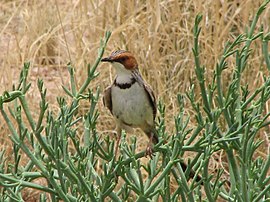Cisticolidae
| Cisticolidae | |
|---|---|

| |
| Golden-headed cisticola (Cisticola exilis) | |
| Scientific classification | |
| Domain: | Eukaryota |
| Kingdom: | Animalia |
| Phylum: | Chordata |
| Class: | Aves |
| Order: | Passeriformes |
| Superfamily: | Sylvioidea |
| Family: | Cisticolidae Sundevall, 1872 |
| Genera | |
|
Many: see text | |
The family Cisticolidae is a group of about 160 warblers, small passerine birds found mainly in warmer southern regions of the Old World. They were formerly included within the Old World warbler family Sylviidae.
This family probably originated in Africa, which has the majority of species, but there are representatives of the family across tropical Asia into Australasia, and one species, the zitting cisticola, breeds in Europe.
These are generally very small birds of drab brown or grey appearance found in open country such as grassland or scrub. They are often difficult to see and many species are similar in appearance, so the song is often the best identification guide. These are insectivorous birds which nest low in vegetation.
Taxonomy
[edit]The family was introduced (as Cisticolinae) by the Swedish zoologist Carl Jakob Sundevall in 1872.[1][2]
Many taxonomists place the red-winged prinia and the red-fronted prinia in the genus Prinia rather than in their own monotypic genera.[3][4] Support for their placement in Prinia is provided by a molecular phylogenetic study of the Cisticolidae published in 2013 that found that both species were closely related to the prinias.[5]
The following genus level cladogram of the Cisticolidae is based on a molecular phylogenetic study by Urban Olsson and collaborators that was published in 2013.[5] The number of species in each genus is taken from the list maintained by Frank Gill, Pamela C. Rasmussen and David Donsker on behalf of the International Ornithological Committee (IOC).[6]
| Cisticolidae |
| ||||||||||||||||||||||||||||||||||||||||||||||||||||||||||||||||||||||||||||||||||||||||||||||||||||||||||||||||||||||||||||||||||||||||||||||||||||||
List of genera
[edit]The family contains 168 species divided into 26 genera:[6] For more detail, see List of Cisticolidae species.
- Neomixis, jeries (3 species) (genus is basal to all other Cisticolidae)[7]
- Cisticola, cisticolas (53 species)
- Incana – monotypic, Socotra warbler (Incana incanus)
- Prinia, prinias (30 species)
- Schistolais (2 species)
- Phragmacia – monotypic, Namaqua warbler (Phragmacia substriata)
- Oreophilais – monotypic, Roberts's warbler (Oreophilais robertsi)

- Micromacronus (2 species)
- Urolais – monotypic, green longtail (Urolais epichlora)
- Oreolais, (2 species) – moved here from Apalis[8]
- Drymocichla – monotypic, red-winged grey warbler (Drymocichla incana)
- Spiloptila – monotypic, cricket warbler (Spiloptila clamans)
- Phyllolais – monotypic, buff-bellied warbler (Phyllolais pulchella)
- Apalis, apalises (26 species)
- Malcorus – monotypic, rufous-eared warbler (Malcorus pectoralis)
- Hypergerus – monotypic, oriole warbler (Hypergerus atriceps)
- Eminia – monotypic, grey-capped warbler (Eminia lepida)
- Camaroptera (5 species)
- Calamonastes (4 species)
- Euryptila – monotypic, cinnamon-breasted warbler (Euryptila subcinnamomea)
- Bathmocercus, rufous warblers (2 species)
- Scepomycter (2 species) - sometimes merged into Bathmocercus
- Orthotomus, tailorbirds (13 species)
- Artisornis (2 species)
- Poliolais – monotypic, white-tailed warbler (Poliolais lopezi)
- Eremomela (10 species)
References
[edit]- ^ Sundevall, Carl Jakob (1872). Methodi naturalis avium disponendarum tentamen. Försök till fogelklassens naturenliga uppställnung (in Latin and Swedish). Stockholm: Samson & Wallin. p. 6.
- ^ Bock, Walter J. (1994). History and Nomenclature of Avian Family-Group Names. Bulletin of the American Museum of Natural History. Vol. 222. New York: American Museum of Natural History. pp. 152, 261.
- ^ Ryan, P.; Dean, R. (2017). del Hoyo, J.; Elliott, A.; Sargatal, J.; Christie, D.A.; de Juana, E. (eds.). "Red-winged Prinia (Prinia erythroptera)". Handbook of the Birds of the World Alive. Lynx Edicions. Retrieved 27 August 2017.
- ^ Ryan, P.; Dean, R. (2017). del Hoyo, J.; Elliott, A.; Sargatal, J.; Christie, D.A.; de Juana, E. (eds.). "Red-fronted Prinia (Prinia rufifrons)". Handbook of the Birds of the World Alive. Lynx Edicions. Retrieved 27 August 2017.
- ^ a b Olsson, U.; Irestedt, M.; Sangster, G.; Ericson, P.G.P.; Alström, P. (2013). "Systematic revision of the avian family Cisticolidae based on a multi-locus phylogeny of all genera". Molecular Phylogenetics and Evolution. 66 (3). doi:10.1016/j.ympev.2012.11.004.
- ^ a b Gill, Frank; Donsker, David; Rasmussen, Pamela, eds. (December 2023). "Grassbirds, Donacobius, tetrakas, cisticolas, allies". IOC World Bird List Version 14.1. International Ornithologists' Union. Retrieved 29 June 2024.
- ^ Nguembock, B.; Fjeldså, J.; Tillier, A.; Pasquet, E. (2007). "A phylogeny for the Cisticolidae (Aves: Passeriformes) based on nuclear and mitochondrial DNA sequence data, and a re-interpretation of an [sic] unique nest-building specialization". Molecular Phylogenetics and Evolution. 42 (1): 272–286. doi:10.1016/j.ympev.2006.07.008. PMID 16949311.
- ^ Nguembock, B.; Fjeldså, J.; Couloux, A.; Cruaud, C.; Pasquet, E. (2008). "Polyphyly of the genus Apalis and a new generic name for the species pulchra and ruwenzorii". Ibis. 150 (4): 756–765. doi:10.1111/j.1474-919X.2008.00852.x.
Further reading
[edit]- Alström, P.; Ericson, P.G.P.; Olsson, U.; Sundberg, P. (2006). "Phylogeny and classification of the avian superfamily Sylvioidea". Molecular Phylogenetics and Evolution. 38: 381–397. doi:10.1016/j.ympev.2005.05.015. PMID 16054402.
- Cibois, A., Slikas, B., Schulenberg, T. S., & Pasquet, E. (2001). An endemic radiation of Malagasy songbirds is revealed by mitochondrial DNA sequence data. Evolution 55 (6): 1198–1206. DOI:10.1554/0014-3820(2001)055[1198:AEROMS]2.0.CO;2 PDF
- Ryan, Peter (2006). Family Cisticolidae (Cisticolas and allies). Pp. 378–492 in del Hoyo J., Elliott A. & Christie D.A. (2006) Handbook of the Birds of the World. Volume 11. Old World Flycatchers to Old World Warblers Lynx Edicions, Barcelona ISBN 978-84-96553-06-4
- Urban, E.K.; Fry, C.H. & Keith, S. (1997) The Birds of Africa, vol. 5. Academic Press, London. ISBN 0-12-137305-3
External links
[edit]- Cisticolidae videos on the Internet Bird Collection
